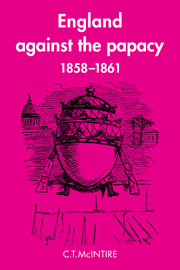 England Against the Papacy 1858–1861
England Against the Papacy 1858–1861 Book contents
- Frontmatter
- Contents
- Acknowledgments
- A note on the footnotes and abbreviations
- Maps
- Introduction
- 1 ‘English Liberties’ and ‘The Government of Priests’
- 2 Odo Russell and the network of English–papal relations
- 3 Tories, the pope, and peace
- 4 Tories, the pope, and war
- 5 Liberals and the revolution in the Romagna
- 6 Liberals, the congress and the Romagna
- 7 Liberals and the annexation of the Romagna
- 8 Liberals and the annexation of the Marches and Umbria
- Conclusion
- Select Bibliography
- Index
- Frontmatter
- Contents
- Acknowledgments
- A note on the footnotes and abbreviations
- Maps
- Introduction
- 1 ‘English Liberties’ and ‘The Government of Priests’
- 2 Odo Russell and the network of English–papal relations
- 3 Tories, the pope, and peace
- 4 Tories, the pope, and war
- 5 Liberals and the revolution in the Romagna
- 6 Liberals, the congress and the Romagna
- 7 Liberals and the annexation of the Romagna
- 8 Liberals and the annexation of the Marches and Umbria
- Conclusion
- Select Bibliography
- Index
Summary
The end of the papal temporal power outside the city and region of Rome, and the formation of the unified kingdom of Italy turned out to be two distinct sides of the same events between 1858 and 1861. What the pope lost, Italy gained. The process which yielded unification, rather than some other result, was not straightforward and not at all inevitable. The Tory government before June 1859 did not even consider the possibility of political unification of the whole peninsula. The Liberals only came to consider it as an option in the summer of 1860, and even then they regarded it as not unquestionably desirable. Unification was forced on England as well as Italy by Garibaldi, the annexationists among the liberal nationalists, and belatedly by Cavour. Russell's decisive 27 October despatch marked English acceptance of a fait accompli.
The overthrow of the pope was different, however. Both the Tory and the Liberal leadership envisioned and actually advocated the end of most of the temporal power from the very beginning of the new crisis in Italy. At the end of 1858, Malmesbury proposed a ‘redistribution’ of papal territory, while simultaneously Russell stated that all the pope should rule over was ‘Rome with fifteen miles around.’ With the approach of war in 1859, Malmesbury, for the time being, dropped open reference to his proposal in order to concentrate on maintaining the Vienna settlement and getting the powers together in a congress as a means of securing peace.
- Type
- Chapter
- Information
- England Against the Papacy 1858–1861Tories, Liberals and the Overthrow of Papal Temporal Power during the Italian Risorgimento, pp. 222 - 227Publisher: Cambridge University PressPrint publication year: 1983
